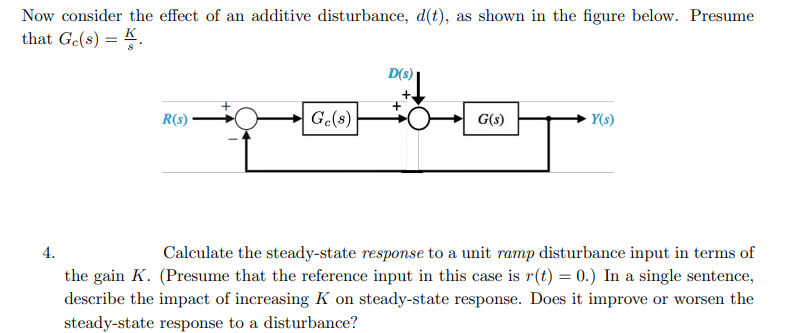Now consider the effect of an additive disturbance, d(t), as shown in the figure below. Presume that Ge(s) = K. D(s) Y(s) R(s) Ge(s) 4. Calculate the steady-state response to a unit ramp disturbance input in terms of the gain K. (Presume that the reference input in this case is r(t) = 0.) In a single sentence, describe the impact of increasing K on steady-state response. Does it improve or worsen the
Now consider the effect of an additive disturbance, d(t), as shown in the figure below. Presume that Ge(s) = K. D(s) Y(s) R(s) Ge(s) 4. Calculate the steady-state response to a unit ramp disturbance input in terms of the gain K. (Presume that the reference input in this case is r(t) = 0.) In a single sentence, describe the impact of increasing K on steady-state response. Does it improve or worsen the
Introductory Circuit Analysis (13th Edition)
13th Edition
ISBN:9780133923605
Author:Robert L. Boylestad
Publisher:Robert L. Boylestad
Chapter1: Introduction
Section: Chapter Questions
Problem 1P: Visit your local library (at school or home) and describe the extent to which it provides literature...
Related questions
Question

Transcribed Image Text:Now consider the effect of an additive disturbance, d(t), as shown in the figure below. Presume
that Ge(s) = K.
D(s)
R(s)
G.(s)
G(s)
- Y(s)
4.
Calculate the steady-state response to a unit ramp disturbance input in terms of
the gain K. (Presume that the reference input in this case is r(t) = 0.) In a single sentence,
describe the impact of increasing K on steady-state response. Does it improve or worsen the
steady-state response to a disturbance?

Transcribed Image Text:MagLev trains can enable speeds not possible with conven-
tional rail systems, because the train is held above the rail
via magnetic forces. A maglev system has been designed to
control height of the train of the rail, with desired height as
input R(s), and actual height as output Y(s). The plant is de- R()
scribed by G(s) =
Controller
Process
G(s)
Y(s)
We will explore two controllers:
= (6+1)(s+2)*
a) Ge(s) = K, and b) Ge(s) = K.
Expert Solution
This question has been solved!
Explore an expertly crafted, step-by-step solution for a thorough understanding of key concepts.
Step by step
Solved in 3 steps

Knowledge Booster
Learn more about
Need a deep-dive on the concept behind this application? Look no further. Learn more about this topic, electrical-engineering and related others by exploring similar questions and additional content below.Recommended textbooks for you

Introductory Circuit Analysis (13th Edition)
Electrical Engineering
ISBN:
9780133923605
Author:
Robert L. Boylestad
Publisher:
PEARSON

Delmar's Standard Textbook Of Electricity
Electrical Engineering
ISBN:
9781337900348
Author:
Stephen L. Herman
Publisher:
Cengage Learning

Programmable Logic Controllers
Electrical Engineering
ISBN:
9780073373843
Author:
Frank D. Petruzella
Publisher:
McGraw-Hill Education

Introductory Circuit Analysis (13th Edition)
Electrical Engineering
ISBN:
9780133923605
Author:
Robert L. Boylestad
Publisher:
PEARSON

Delmar's Standard Textbook Of Electricity
Electrical Engineering
ISBN:
9781337900348
Author:
Stephen L. Herman
Publisher:
Cengage Learning

Programmable Logic Controllers
Electrical Engineering
ISBN:
9780073373843
Author:
Frank D. Petruzella
Publisher:
McGraw-Hill Education

Fundamentals of Electric Circuits
Electrical Engineering
ISBN:
9780078028229
Author:
Charles K Alexander, Matthew Sadiku
Publisher:
McGraw-Hill Education

Electric Circuits. (11th Edition)
Electrical Engineering
ISBN:
9780134746968
Author:
James W. Nilsson, Susan Riedel
Publisher:
PEARSON

Engineering Electromagnetics
Electrical Engineering
ISBN:
9780078028151
Author:
Hayt, William H. (william Hart), Jr, BUCK, John A.
Publisher:
Mcgraw-hill Education,